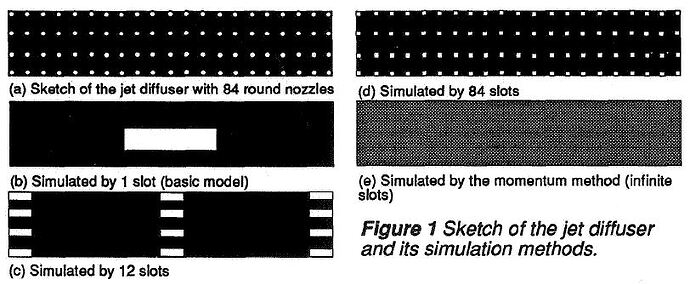Hello SimScaler
For indoor climate analysis the correct modelling of air supply diffusors are essential. This means air flow rate an inlet velocity need to be accurate.
Since the geometry of diffusor cant be modelled directly (unpractical) simplification are been made. One of these simplification is called the momentum method, described here: iea.org. In this paper a jet diffusor with 84 round nozzles (picture below (a)) is in different methods simulated (b,c,d,e) and the results with measurements compared.
As results of those 4 different methods (b,c,d,e) simulated and compared. Only (e) the momentum method correctly predict air flow. Now keep in mind that the surface area of the momentum method is the same as the gross area of the diffusor (a). The effective area of the diffuoser (nozzles → white area in the picture) are way smaller.
What i try do understand is how to model the momentum method within simscale. From the paper:
In the momentum method boundary conditions for the continuity equation and momentum equations are set separately so that the Inlet area can be chosen freely. Volume flow rate Qv and momentum Qu, of supplied air belonging to the actual diffuser are specified for an opening with the same dimensions as the area occupied by the nozzles (gross area): The momentum method can be regarded as setting infinite nozzleslslots as shown in figure 2.4.
Since the simplified diffusor (e) has a much larger effective surface area (= gross area) flowrate and velocity needs to be decoupled. If i understand correctly, this is not possible with an existing boundary condition in simscale? Any ideas on this topic?
regards
david
